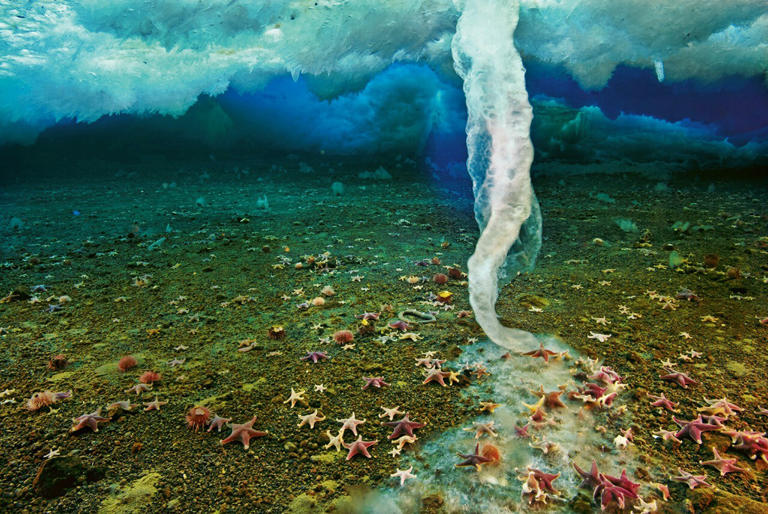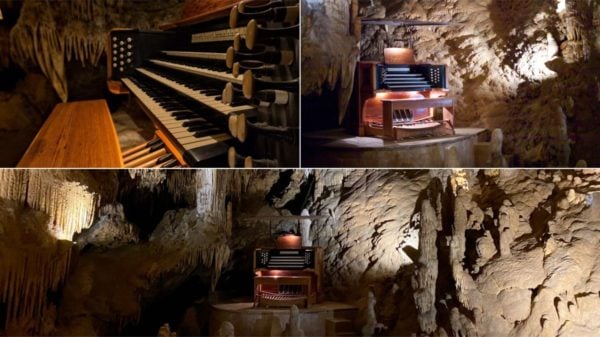For humans, there are many creatures so deadly that we know never to cross their paths. While many of them look scary and have intimidating sizes, statistics show that the deadliest of them are not creatures that people often find frightening. For example, mosquitoes, freshwater snails, and tsetse flies have killed more humans than lions and crocodiles.
It’s a similar story for sea creatures who must do everything they can not to get in the way of the innocent-looking, spectacular, and yet deadly brinicles. Interestingly, brinicles aren’t living creatures. Instead, they’re unique formations similar to hydrothermal vents or stalactites on the surface of caves that are formed from brine and icicle.
An Oregon State University professor, Andrew Thurber, who has seen them firsthand, says that they resemble “upside-down cacti that are blown from glass, like something from Dr. Seuss’s imagination.” He also added that they are “incredibly delicate and can break with only the slightest touch.” But don’t let this fool you. These delicate formations, like mosquitoes, are as deadly as they come. Reports have it that they’ll freeze any marine life that is caught in their paths, including sea urchins or starfish, to death.
Typically found in the Antarctic ocean and oceans in the polar regions, brinicles are commonly referred to as, “the icy fingers of death” because they look like fingers of ice that extend as far down as the ocean floor. Unfortunately, this structure is hardly caught on camera due to the fact that it occurs beneath floating sea ice. However, BBC’s Frozen Planet Series has released video footage of the eye-catching brinicles.
The icy fingers of death sound like a ridiculous story from a Sci-Fi movie. However, there’s a logical and scientifically-proven explanation for this occurrence. According to a study, some ions, including salt, that are typically present in seawater are left out as pure ice crystal freezes in the Antarctic and Arctic regions. This leads to the formation of concentrated salt water (brine), in the sea ice, in numerous channels and fractions.
Brine, because of its salt concentration, can only get frozen under very low temperatures and, for this reason, will remain in its liquid state until the ice breaks and gives it ample room to leak into the ocean underneath. However, because brine is significantly heavier than the water surrounding it, it sinks deep into the ocean floor.
Due to its extra coldness, it freezes the seawater along its path. It takes the shape of a tube while descending, with the inner wall melting steadily as the outside wall becomes frozen. This process causes the tube to develop downward into an icy stalactite. Put simply, this is the phenomenon behind its finger-like appearance.
Brinicles can reach a diameter of 25cm and typically grows many meters daily. As it approaches the seafloor, it extends into ice sheets (anchor ice) that attach to the seabed and grow very fast to enable it to catch up (and even overtake) sea creatures on its way. It engulfs them and freezes them to death at the exact spot they were caught.
It’s worthy of note that this complex process was first discovered as far back as the 1960s, even though it wasn’t until 2011 that they were filmed. To date, no one fully understands the complete details of the process. However, it can be said with a reasonable degree of certainty that brinicles form in a similar way as hydrothermal vents.
Hydrothermal vents, which scientists believe to be the beginning of life on the planet, are formed when the seafloor ejects hot water filled with ions. This creates an upward-moving porous metal tower that water can rush through. The force from the water rushing through the tower ruptures it, allowing for the tower to become expanded by the increased volume of metal-rich water.
One important question that arises from the study of brinicles and how well they mimic hydrothermal vent formations is whether they’re also cradles of life. According to Bruno Escribano, a study author from the Spanish Basque Center for Applied Mathematics, this may well be the case. In his words, “Inside these compartments inside the ice, you have a high concentration of chemical compounds, and you also have lipids, fats, that coat the inside of the compartment. These can act as a primitive membrane — one of the conditions necessary for life.”
Escribano explained further that basic and acidic components form the insides of a brinicle. This combination may be capable of supplying the needed energy to form more complex molecules. In fact, he believes that it may even be able to support DNA formations. While the theories regarding the roles brinicles play in the origins of life remain mere speculations, one thing is sure—there’s still a whole lot to learn about the amazing brinicles. We can’t wait to discover more about the fascinating fingers of death that create a jaw-dropping sight for divers as they pass by.






























